Content and Application of the IASB Conceptual Framework Report
VerifiedAdded on 2022/12/09
|10
|2213
|351
Report
AI Summary
This report provides a comprehensive overview of the IASB Conceptual Framework. It begins by outlining the framework's purpose, emphasizing its role in establishing accounting policies and resolving conflicts within existing standards. The report then delves into the content of the framework, detailing its objectives, fundamental principles, and qualitative characteristics used to evaluate financial statements. It also covers key concepts like recognition, measurement, and capital management. Finally, the report explores the application of the framework, demonstrating how its principles are applied to various financial transactions and the preparation of financial statements, ensuring fair and consistent reporting across different entities and industries. The report concludes by highlighting the significance of the IASB Conceptual Framework in promoting transparency and comparability in financial reporting.
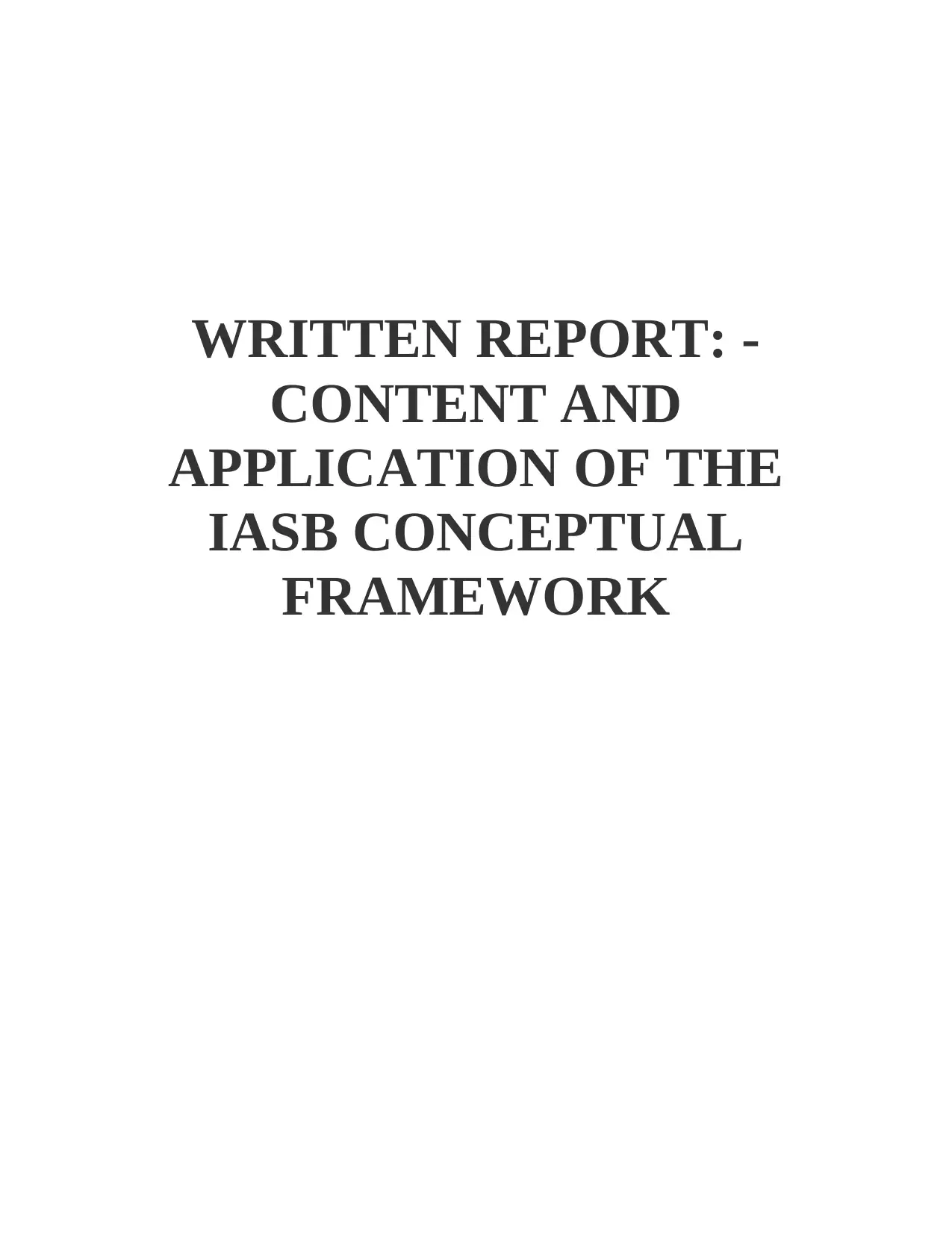
WRITTEN REPORT: -
CONTENT AND
APPLICATION OF THE
IASB CONCEPTUAL
FRAMEWORK
CONTENT AND
APPLICATION OF THE
IASB CONCEPTUAL
FRAMEWORK
Paraphrase This Document
Need a fresh take? Get an instant paraphrase of this document with our AI Paraphraser
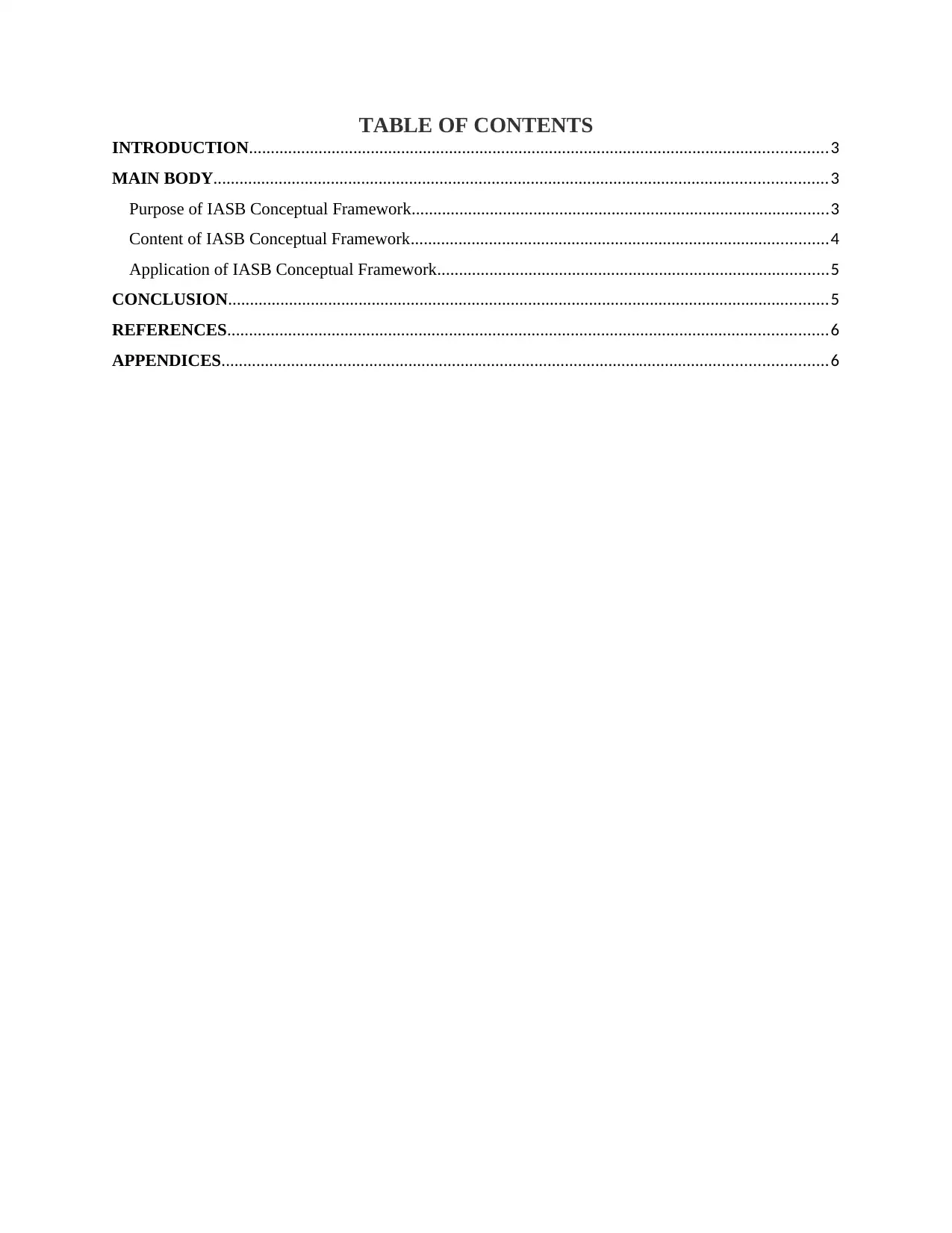
TABLE OF CONTENTS
INTRODUCTION.....................................................................................................................................3
MAIN BODY.............................................................................................................................................3
Purpose of IASB Conceptual Framework................................................................................................3
Content of IASB Conceptual Framework................................................................................................4
Application of IASB Conceptual Framework..........................................................................................5
CONCLUSION..........................................................................................................................................5
REFERENCES..........................................................................................................................................6
APPENDICES...........................................................................................................................................6
INTRODUCTION.....................................................................................................................................3
MAIN BODY.............................................................................................................................................3
Purpose of IASB Conceptual Framework................................................................................................3
Content of IASB Conceptual Framework................................................................................................4
Application of IASB Conceptual Framework..........................................................................................5
CONCLUSION..........................................................................................................................................5
REFERENCES..........................................................................................................................................6
APPENDICES...........................................................................................................................................6
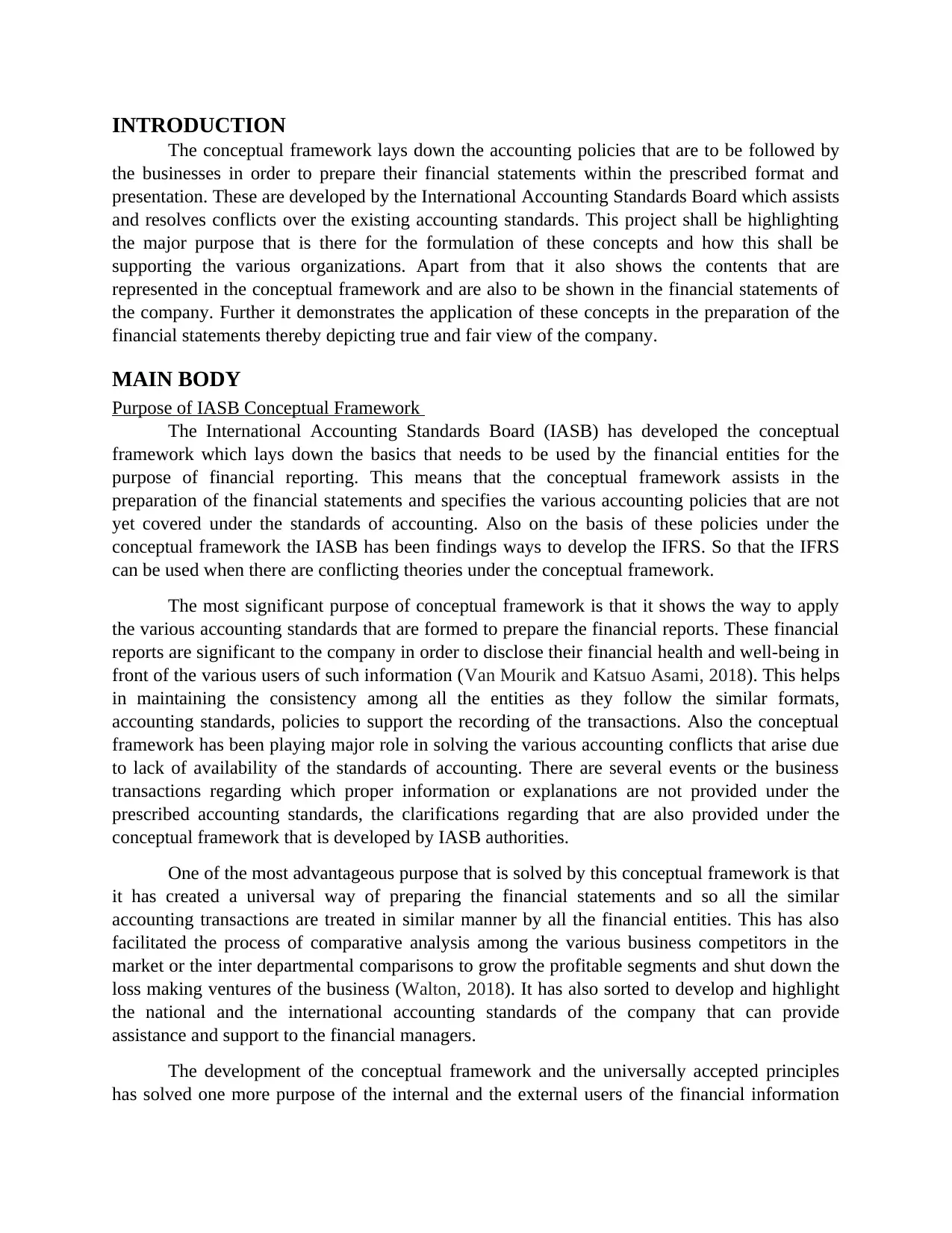
INTRODUCTION
The conceptual framework lays down the accounting policies that are to be followed by
the businesses in order to prepare their financial statements within the prescribed format and
presentation. These are developed by the International Accounting Standards Board which assists
and resolves conflicts over the existing accounting standards. This project shall be highlighting
the major purpose that is there for the formulation of these concepts and how this shall be
supporting the various organizations. Apart from that it also shows the contents that are
represented in the conceptual framework and are also to be shown in the financial statements of
the company. Further it demonstrates the application of these concepts in the preparation of the
financial statements thereby depicting true and fair view of the company.
MAIN BODY
Purpose of IASB Conceptual Framework
The International Accounting Standards Board (IASB) has developed the conceptual
framework which lays down the basics that needs to be used by the financial entities for the
purpose of financial reporting. This means that the conceptual framework assists in the
preparation of the financial statements and specifies the various accounting policies that are not
yet covered under the standards of accounting. Also on the basis of these policies under the
conceptual framework the IASB has been findings ways to develop the IFRS. So that the IFRS
can be used when there are conflicting theories under the conceptual framework.
The most significant purpose of conceptual framework is that it shows the way to apply
the various accounting standards that are formed to prepare the financial reports. These financial
reports are significant to the company in order to disclose their financial health and well-being in
front of the various users of such information (Van Mourik and Katsuo Asami, 2018). This helps
in maintaining the consistency among all the entities as they follow the similar formats,
accounting standards, policies to support the recording of the transactions. Also the conceptual
framework has been playing major role in solving the various accounting conflicts that arise due
to lack of availability of the standards of accounting. There are several events or the business
transactions regarding which proper information or explanations are not provided under the
prescribed accounting standards, the clarifications regarding that are also provided under the
conceptual framework that is developed by IASB authorities.
One of the most advantageous purpose that is solved by this conceptual framework is that
it has created a universal way of preparing the financial statements and so all the similar
accounting transactions are treated in similar manner by all the financial entities. This has also
facilitated the process of comparative analysis among the various business competitors in the
market or the inter departmental comparisons to grow the profitable segments and shut down the
loss making ventures of the business (Walton, 2018). It has also sorted to develop and highlight
the national and the international accounting standards of the company that can provide
assistance and support to the financial managers.
The development of the conceptual framework and the universally accepted principles
has solved one more purpose of the internal and the external users of the financial information
The conceptual framework lays down the accounting policies that are to be followed by
the businesses in order to prepare their financial statements within the prescribed format and
presentation. These are developed by the International Accounting Standards Board which assists
and resolves conflicts over the existing accounting standards. This project shall be highlighting
the major purpose that is there for the formulation of these concepts and how this shall be
supporting the various organizations. Apart from that it also shows the contents that are
represented in the conceptual framework and are also to be shown in the financial statements of
the company. Further it demonstrates the application of these concepts in the preparation of the
financial statements thereby depicting true and fair view of the company.
MAIN BODY
Purpose of IASB Conceptual Framework
The International Accounting Standards Board (IASB) has developed the conceptual
framework which lays down the basics that needs to be used by the financial entities for the
purpose of financial reporting. This means that the conceptual framework assists in the
preparation of the financial statements and specifies the various accounting policies that are not
yet covered under the standards of accounting. Also on the basis of these policies under the
conceptual framework the IASB has been findings ways to develop the IFRS. So that the IFRS
can be used when there are conflicting theories under the conceptual framework.
The most significant purpose of conceptual framework is that it shows the way to apply
the various accounting standards that are formed to prepare the financial reports. These financial
reports are significant to the company in order to disclose their financial health and well-being in
front of the various users of such information (Van Mourik and Katsuo Asami, 2018). This helps
in maintaining the consistency among all the entities as they follow the similar formats,
accounting standards, policies to support the recording of the transactions. Also the conceptual
framework has been playing major role in solving the various accounting conflicts that arise due
to lack of availability of the standards of accounting. There are several events or the business
transactions regarding which proper information or explanations are not provided under the
prescribed accounting standards, the clarifications regarding that are also provided under the
conceptual framework that is developed by IASB authorities.
One of the most advantageous purpose that is solved by this conceptual framework is that
it has created a universal way of preparing the financial statements and so all the similar
accounting transactions are treated in similar manner by all the financial entities. This has also
facilitated the process of comparative analysis among the various business competitors in the
market or the inter departmental comparisons to grow the profitable segments and shut down the
loss making ventures of the business (Walton, 2018). It has also sorted to develop and highlight
the national and the international accounting standards of the company that can provide
assistance and support to the financial managers.
The development of the conceptual framework and the universally accepted principles
has solved one more purpose of the internal and the external users of the financial information
⊘ This is a preview!⊘
Do you want full access?
Subscribe today to unlock all pages.

Trusted by 1+ million students worldwide
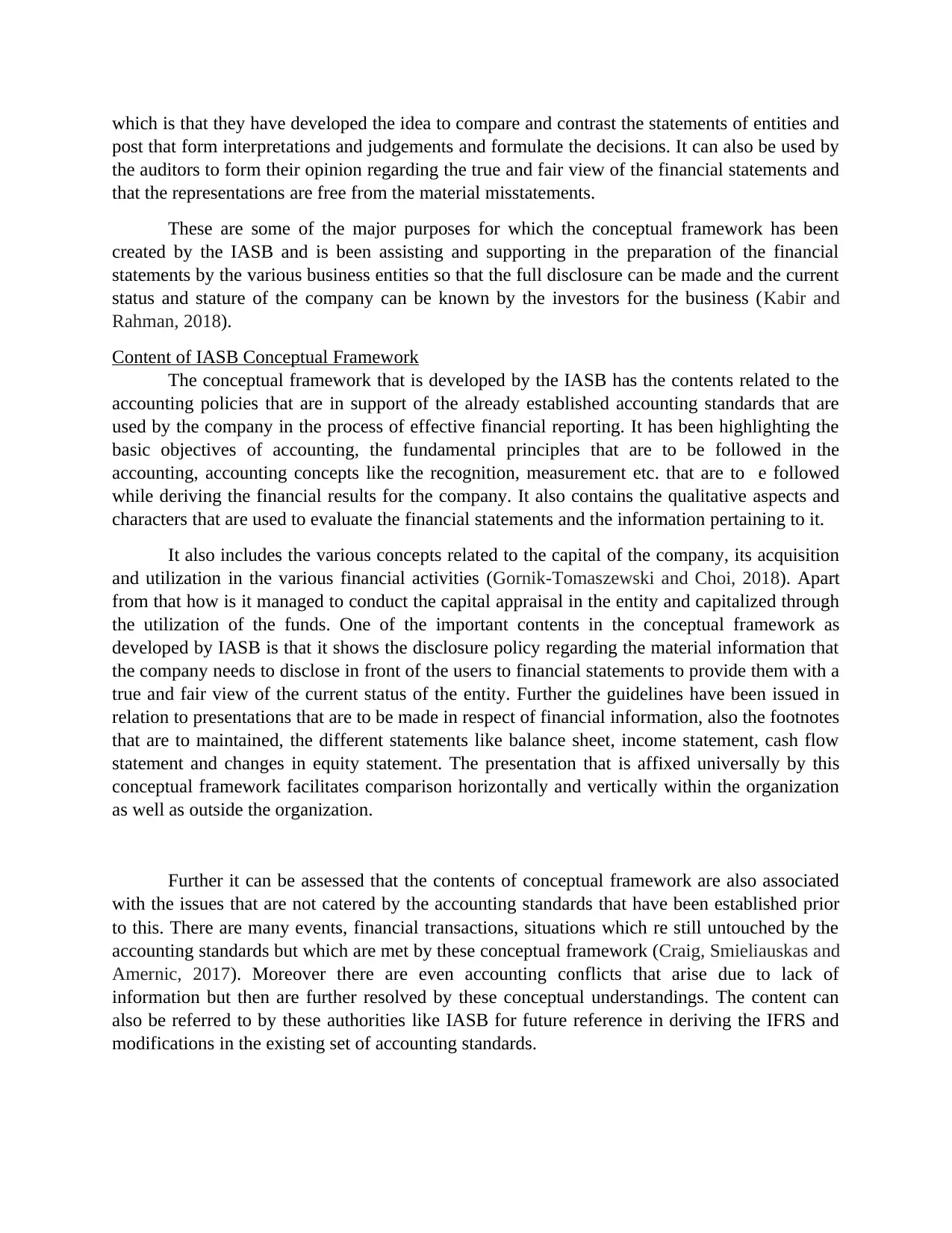
which is that they have developed the idea to compare and contrast the statements of entities and
post that form interpretations and judgements and formulate the decisions. It can also be used by
the auditors to form their opinion regarding the true and fair view of the financial statements and
that the representations are free from the material misstatements.
These are some of the major purposes for which the conceptual framework has been
created by the IASB and is been assisting and supporting in the preparation of the financial
statements by the various business entities so that the full disclosure can be made and the current
status and stature of the company can be known by the investors for the business (Kabir and
Rahman, 2018).
Content of IASB Conceptual Framework
The conceptual framework that is developed by the IASB has the contents related to the
accounting policies that are in support of the already established accounting standards that are
used by the company in the process of effective financial reporting. It has been highlighting the
basic objectives of accounting, the fundamental principles that are to be followed in the
accounting, accounting concepts like the recognition, measurement etc. that are to e followed
while deriving the financial results for the company. It also contains the qualitative aspects and
characters that are used to evaluate the financial statements and the information pertaining to it.
It also includes the various concepts related to the capital of the company, its acquisition
and utilization in the various financial activities (Gornik-Tomaszewski and Choi, 2018). Apart
from that how is it managed to conduct the capital appraisal in the entity and capitalized through
the utilization of the funds. One of the important contents in the conceptual framework as
developed by IASB is that it shows the disclosure policy regarding the material information that
the company needs to disclose in front of the users to financial statements to provide them with a
true and fair view of the current status of the entity. Further the guidelines have been issued in
relation to presentations that are to be made in respect of financial information, also the footnotes
that are to maintained, the different statements like balance sheet, income statement, cash flow
statement and changes in equity statement. The presentation that is affixed universally by this
conceptual framework facilitates comparison horizontally and vertically within the organization
as well as outside the organization.
Further it can be assessed that the contents of conceptual framework are also associated
with the issues that are not catered by the accounting standards that have been established prior
to this. There are many events, financial transactions, situations which re still untouched by the
accounting standards but which are met by these conceptual framework (Craig, Smieliauskas and
Amernic, 2017). Moreover there are even accounting conflicts that arise due to lack of
information but then are further resolved by these conceptual understandings. The content can
also be referred to by these authorities like IASB for future reference in deriving the IFRS and
modifications in the existing set of accounting standards.
post that form interpretations and judgements and formulate the decisions. It can also be used by
the auditors to form their opinion regarding the true and fair view of the financial statements and
that the representations are free from the material misstatements.
These are some of the major purposes for which the conceptual framework has been
created by the IASB and is been assisting and supporting in the preparation of the financial
statements by the various business entities so that the full disclosure can be made and the current
status and stature of the company can be known by the investors for the business (Kabir and
Rahman, 2018).
Content of IASB Conceptual Framework
The conceptual framework that is developed by the IASB has the contents related to the
accounting policies that are in support of the already established accounting standards that are
used by the company in the process of effective financial reporting. It has been highlighting the
basic objectives of accounting, the fundamental principles that are to be followed in the
accounting, accounting concepts like the recognition, measurement etc. that are to e followed
while deriving the financial results for the company. It also contains the qualitative aspects and
characters that are used to evaluate the financial statements and the information pertaining to it.
It also includes the various concepts related to the capital of the company, its acquisition
and utilization in the various financial activities (Gornik-Tomaszewski and Choi, 2018). Apart
from that how is it managed to conduct the capital appraisal in the entity and capitalized through
the utilization of the funds. One of the important contents in the conceptual framework as
developed by IASB is that it shows the disclosure policy regarding the material information that
the company needs to disclose in front of the users to financial statements to provide them with a
true and fair view of the current status of the entity. Further the guidelines have been issued in
relation to presentations that are to be made in respect of financial information, also the footnotes
that are to maintained, the different statements like balance sheet, income statement, cash flow
statement and changes in equity statement. The presentation that is affixed universally by this
conceptual framework facilitates comparison horizontally and vertically within the organization
as well as outside the organization.
Further it can be assessed that the contents of conceptual framework are also associated
with the issues that are not catered by the accounting standards that have been established prior
to this. There are many events, financial transactions, situations which re still untouched by the
accounting standards but which are met by these conceptual framework (Craig, Smieliauskas and
Amernic, 2017). Moreover there are even accounting conflicts that arise due to lack of
information but then are further resolved by these conceptual understandings. The content can
also be referred to by these authorities like IASB for future reference in deriving the IFRS and
modifications in the existing set of accounting standards.
Paraphrase This Document
Need a fresh take? Get an instant paraphrase of this document with our AI Paraphraser
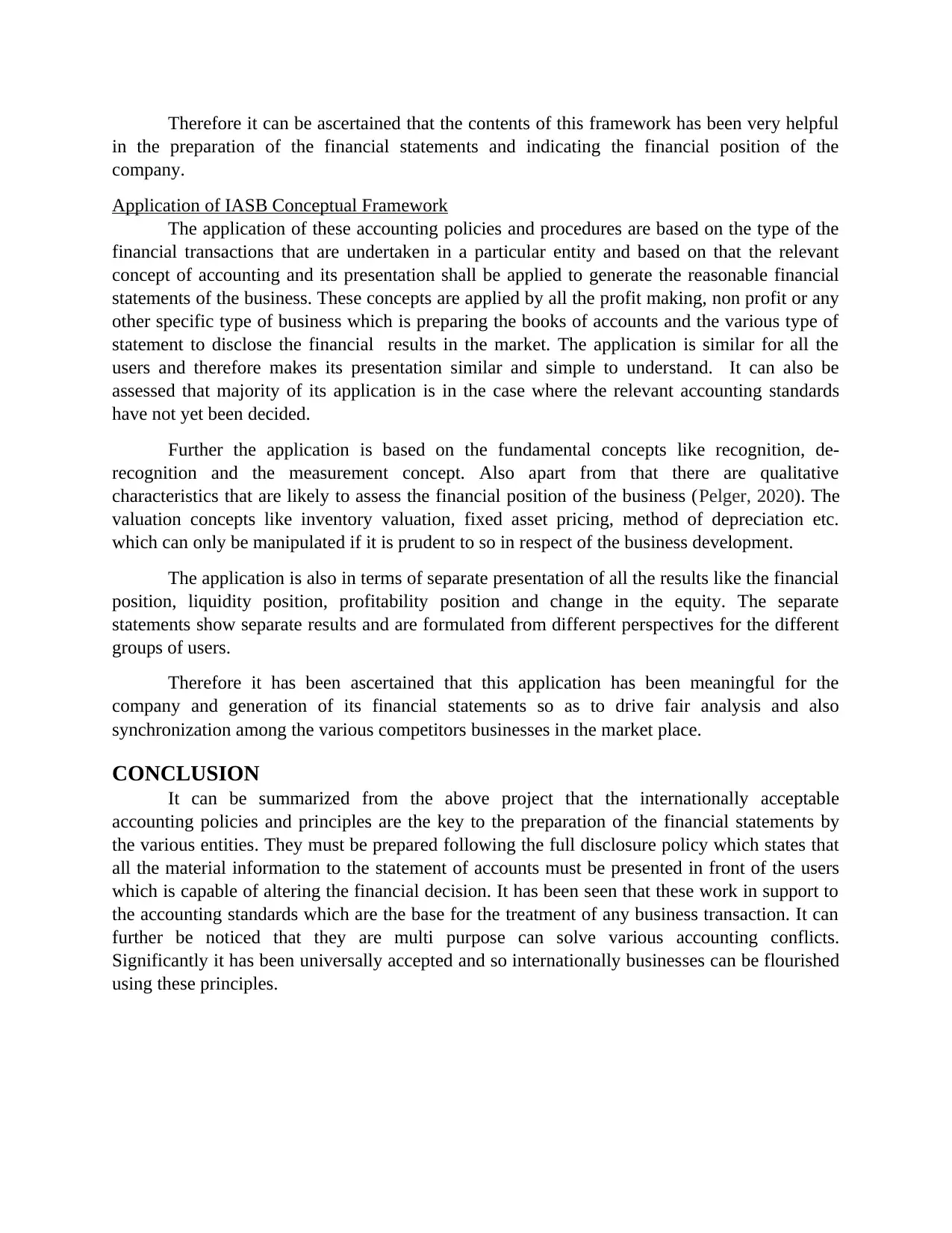
Therefore it can be ascertained that the contents of this framework has been very helpful
in the preparation of the financial statements and indicating the financial position of the
company.
Application of IASB Conceptual Framework
The application of these accounting policies and procedures are based on the type of the
financial transactions that are undertaken in a particular entity and based on that the relevant
concept of accounting and its presentation shall be applied to generate the reasonable financial
statements of the business. These concepts are applied by all the profit making, non profit or any
other specific type of business which is preparing the books of accounts and the various type of
statement to disclose the financial results in the market. The application is similar for all the
users and therefore makes its presentation similar and simple to understand. It can also be
assessed that majority of its application is in the case where the relevant accounting standards
have not yet been decided.
Further the application is based on the fundamental concepts like recognition, de-
recognition and the measurement concept. Also apart from that there are qualitative
characteristics that are likely to assess the financial position of the business (Pelger, 2020). The
valuation concepts like inventory valuation, fixed asset pricing, method of depreciation etc.
which can only be manipulated if it is prudent to so in respect of the business development.
The application is also in terms of separate presentation of all the results like the financial
position, liquidity position, profitability position and change in the equity. The separate
statements show separate results and are formulated from different perspectives for the different
groups of users.
Therefore it has been ascertained that this application has been meaningful for the
company and generation of its financial statements so as to drive fair analysis and also
synchronization among the various competitors businesses in the market place.
CONCLUSION
It can be summarized from the above project that the internationally acceptable
accounting policies and principles are the key to the preparation of the financial statements by
the various entities. They must be prepared following the full disclosure policy which states that
all the material information to the statement of accounts must be presented in front of the users
which is capable of altering the financial decision. It has been seen that these work in support to
the accounting standards which are the base for the treatment of any business transaction. It can
further be noticed that they are multi purpose can solve various accounting conflicts.
Significantly it has been universally accepted and so internationally businesses can be flourished
using these principles.
in the preparation of the financial statements and indicating the financial position of the
company.
Application of IASB Conceptual Framework
The application of these accounting policies and procedures are based on the type of the
financial transactions that are undertaken in a particular entity and based on that the relevant
concept of accounting and its presentation shall be applied to generate the reasonable financial
statements of the business. These concepts are applied by all the profit making, non profit or any
other specific type of business which is preparing the books of accounts and the various type of
statement to disclose the financial results in the market. The application is similar for all the
users and therefore makes its presentation similar and simple to understand. It can also be
assessed that majority of its application is in the case where the relevant accounting standards
have not yet been decided.
Further the application is based on the fundamental concepts like recognition, de-
recognition and the measurement concept. Also apart from that there are qualitative
characteristics that are likely to assess the financial position of the business (Pelger, 2020). The
valuation concepts like inventory valuation, fixed asset pricing, method of depreciation etc.
which can only be manipulated if it is prudent to so in respect of the business development.
The application is also in terms of separate presentation of all the results like the financial
position, liquidity position, profitability position and change in the equity. The separate
statements show separate results and are formulated from different perspectives for the different
groups of users.
Therefore it has been ascertained that this application has been meaningful for the
company and generation of its financial statements so as to drive fair analysis and also
synchronization among the various competitors businesses in the market place.
CONCLUSION
It can be summarized from the above project that the internationally acceptable
accounting policies and principles are the key to the preparation of the financial statements by
the various entities. They must be prepared following the full disclosure policy which states that
all the material information to the statement of accounts must be presented in front of the users
which is capable of altering the financial decision. It has been seen that these work in support to
the accounting standards which are the base for the treatment of any business transaction. It can
further be noticed that they are multi purpose can solve various accounting conflicts.
Significantly it has been universally accepted and so internationally businesses can be flourished
using these principles.
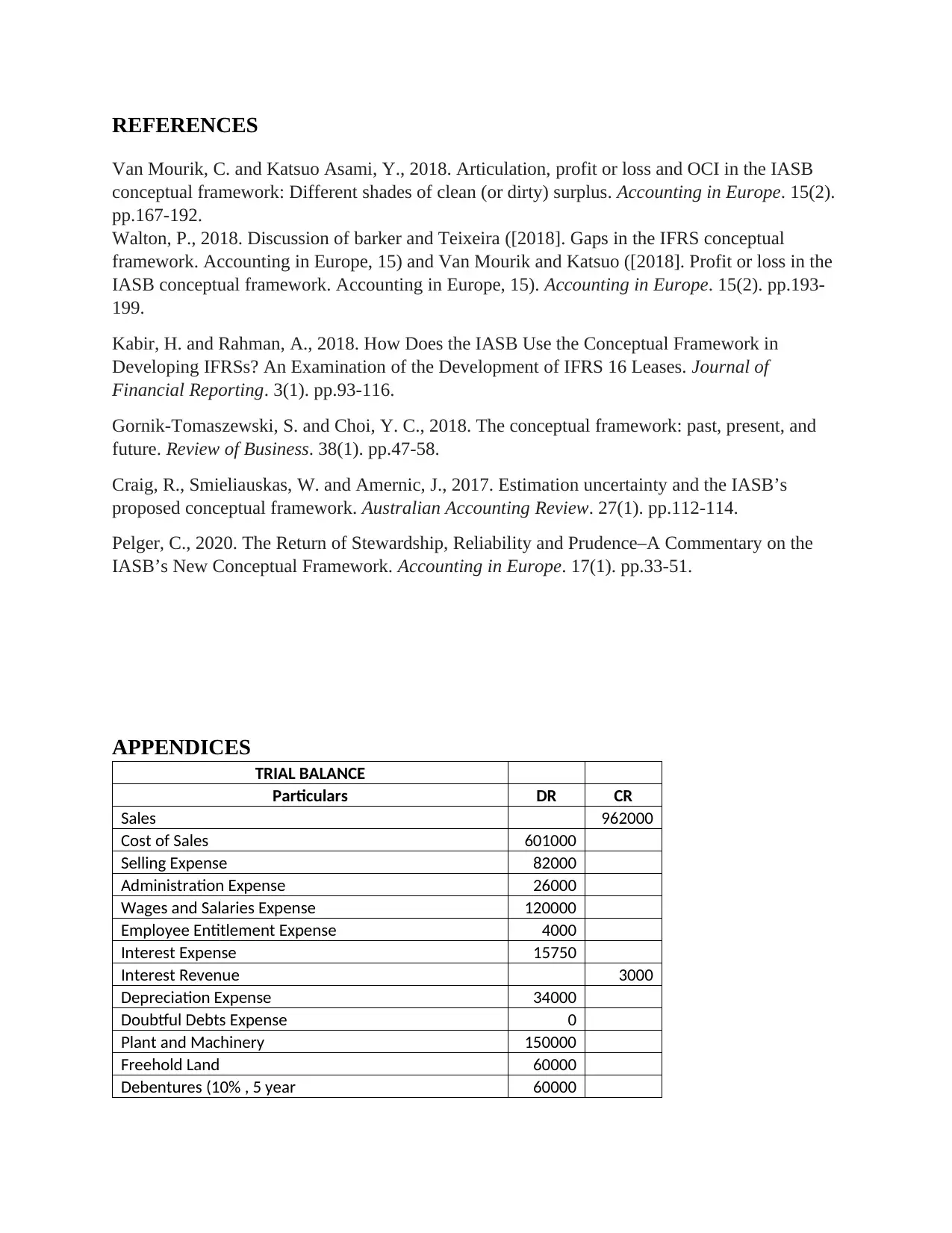
REFERENCES
Van Mourik, C. and Katsuo Asami, Y., 2018. Articulation, profit or loss and OCI in the IASB
conceptual framework: Different shades of clean (or dirty) surplus. Accounting in Europe. 15(2).
pp.167-192.
Walton, P., 2018. Discussion of barker and Teixeira ([2018]. Gaps in the IFRS conceptual
framework. Accounting in Europe, 15) and Van Mourik and Katsuo ([2018]. Profit or loss in the
IASB conceptual framework. Accounting in Europe, 15). Accounting in Europe. 15(2). pp.193-
199.
Kabir, H. and Rahman, A., 2018. How Does the IASB Use the Conceptual Framework in
Developing IFRSs? An Examination of the Development of IFRS 16 Leases. Journal of
Financial Reporting. 3(1). pp.93-116.
Gornik-Tomaszewski, S. and Choi, Y. C., 2018. The conceptual framework: past, present, and
future. Review of Business. 38(1). pp.47-58.
Craig, R., Smieliauskas, W. and Amernic, J., 2017. Estimation uncertainty and the IASB’s
proposed conceptual framework. Australian Accounting Review. 27(1). pp.112-114.
Pelger, C., 2020. The Return of Stewardship, Reliability and Prudence–A Commentary on the
IASB’s New Conceptual Framework. Accounting in Europe. 17(1). pp.33-51.
APPENDICES
TRIAL BALANCE
Particulars DR CR
Sales 962000
Cost of Sales 601000
Selling Expense 82000
Administration Expense 26000
Wages and Salaries Expense 120000
Employee Entitlement Expense 4000
Interest Expense 15750
Interest Revenue 3000
Depreciation Expense 34000
Doubtful Debts Expense 0
Plant and Machinery 150000
Freehold Land 60000
Debentures (10% , 5 year 60000
Van Mourik, C. and Katsuo Asami, Y., 2018. Articulation, profit or loss and OCI in the IASB
conceptual framework: Different shades of clean (or dirty) surplus. Accounting in Europe. 15(2).
pp.167-192.
Walton, P., 2018. Discussion of barker and Teixeira ([2018]. Gaps in the IFRS conceptual
framework. Accounting in Europe, 15) and Van Mourik and Katsuo ([2018]. Profit or loss in the
IASB conceptual framework. Accounting in Europe, 15). Accounting in Europe. 15(2). pp.193-
199.
Kabir, H. and Rahman, A., 2018. How Does the IASB Use the Conceptual Framework in
Developing IFRSs? An Examination of the Development of IFRS 16 Leases. Journal of
Financial Reporting. 3(1). pp.93-116.
Gornik-Tomaszewski, S. and Choi, Y. C., 2018. The conceptual framework: past, present, and
future. Review of Business. 38(1). pp.47-58.
Craig, R., Smieliauskas, W. and Amernic, J., 2017. Estimation uncertainty and the IASB’s
proposed conceptual framework. Australian Accounting Review. 27(1). pp.112-114.
Pelger, C., 2020. The Return of Stewardship, Reliability and Prudence–A Commentary on the
IASB’s New Conceptual Framework. Accounting in Europe. 17(1). pp.33-51.
APPENDICES
TRIAL BALANCE
Particulars DR CR
Sales 962000
Cost of Sales 601000
Selling Expense 82000
Administration Expense 26000
Wages and Salaries Expense 120000
Employee Entitlement Expense 4000
Interest Expense 15750
Interest Revenue 3000
Depreciation Expense 34000
Doubtful Debts Expense 0
Plant and Machinery 150000
Freehold Land 60000
Debentures (10% , 5 year 60000
⊘ This is a preview!⊘
Do you want full access?
Subscribe today to unlock all pages.

Trusted by 1+ million students worldwide
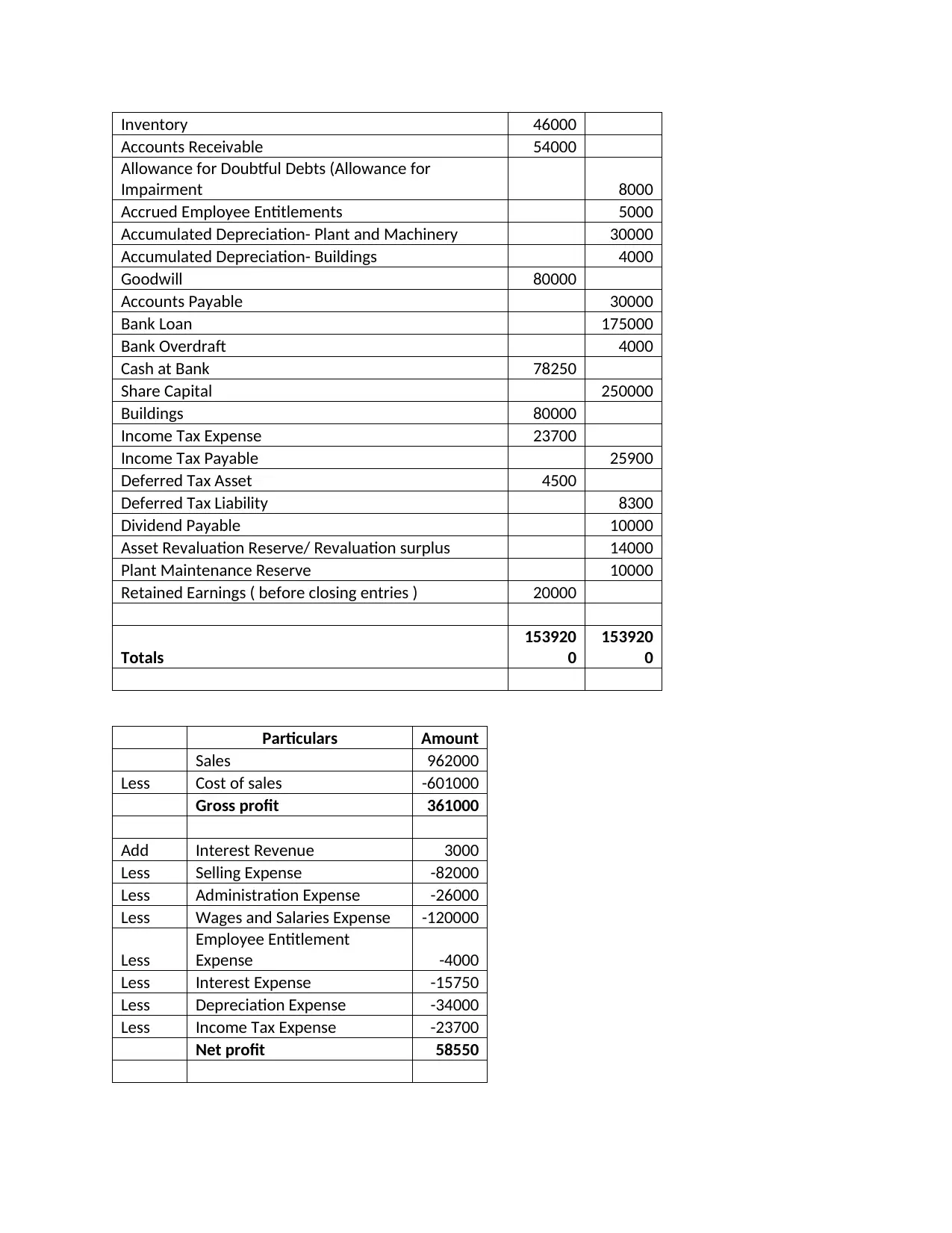
Inventory 46000
Accounts Receivable 54000
Allowance for Doubtful Debts (Allowance for
Impairment 8000
Accrued Employee Entitlements 5000
Accumulated Depreciation- Plant and Machinery 30000
Accumulated Depreciation- Buildings 4000
Goodwill 80000
Accounts Payable 30000
Bank Loan 175000
Bank Overdraft 4000
Cash at Bank 78250
Share Capital 250000
Buildings 80000
Income Tax Expense 23700
Income Tax Payable 25900
Deferred Tax Asset 4500
Deferred Tax Liability 8300
Dividend Payable 10000
Asset Revaluation Reserve/ Revaluation surplus 14000
Plant Maintenance Reserve 10000
Retained Earnings ( before closing entries ) 20000
Totals
153920
0
153920
0
Particulars Amount
Sales 962000
Less Cost of sales -601000
Gross profit 361000
Add Interest Revenue 3000
Less Selling Expense -82000
Less Administration Expense -26000
Less Wages and Salaries Expense -120000
Less
Employee Entitlement
Expense -4000
Less Interest Expense -15750
Less Depreciation Expense -34000
Less Income Tax Expense -23700
Net profit 58550
Accounts Receivable 54000
Allowance for Doubtful Debts (Allowance for
Impairment 8000
Accrued Employee Entitlements 5000
Accumulated Depreciation- Plant and Machinery 30000
Accumulated Depreciation- Buildings 4000
Goodwill 80000
Accounts Payable 30000
Bank Loan 175000
Bank Overdraft 4000
Cash at Bank 78250
Share Capital 250000
Buildings 80000
Income Tax Expense 23700
Income Tax Payable 25900
Deferred Tax Asset 4500
Deferred Tax Liability 8300
Dividend Payable 10000
Asset Revaluation Reserve/ Revaluation surplus 14000
Plant Maintenance Reserve 10000
Retained Earnings ( before closing entries ) 20000
Totals
153920
0
153920
0
Particulars Amount
Sales 962000
Less Cost of sales -601000
Gross profit 361000
Add Interest Revenue 3000
Less Selling Expense -82000
Less Administration Expense -26000
Less Wages and Salaries Expense -120000
Less
Employee Entitlement
Expense -4000
Less Interest Expense -15750
Less Depreciation Expense -34000
Less Income Tax Expense -23700
Net profit 58550
Paraphrase This Document
Need a fresh take? Get an instant paraphrase of this document with our AI Paraphraser
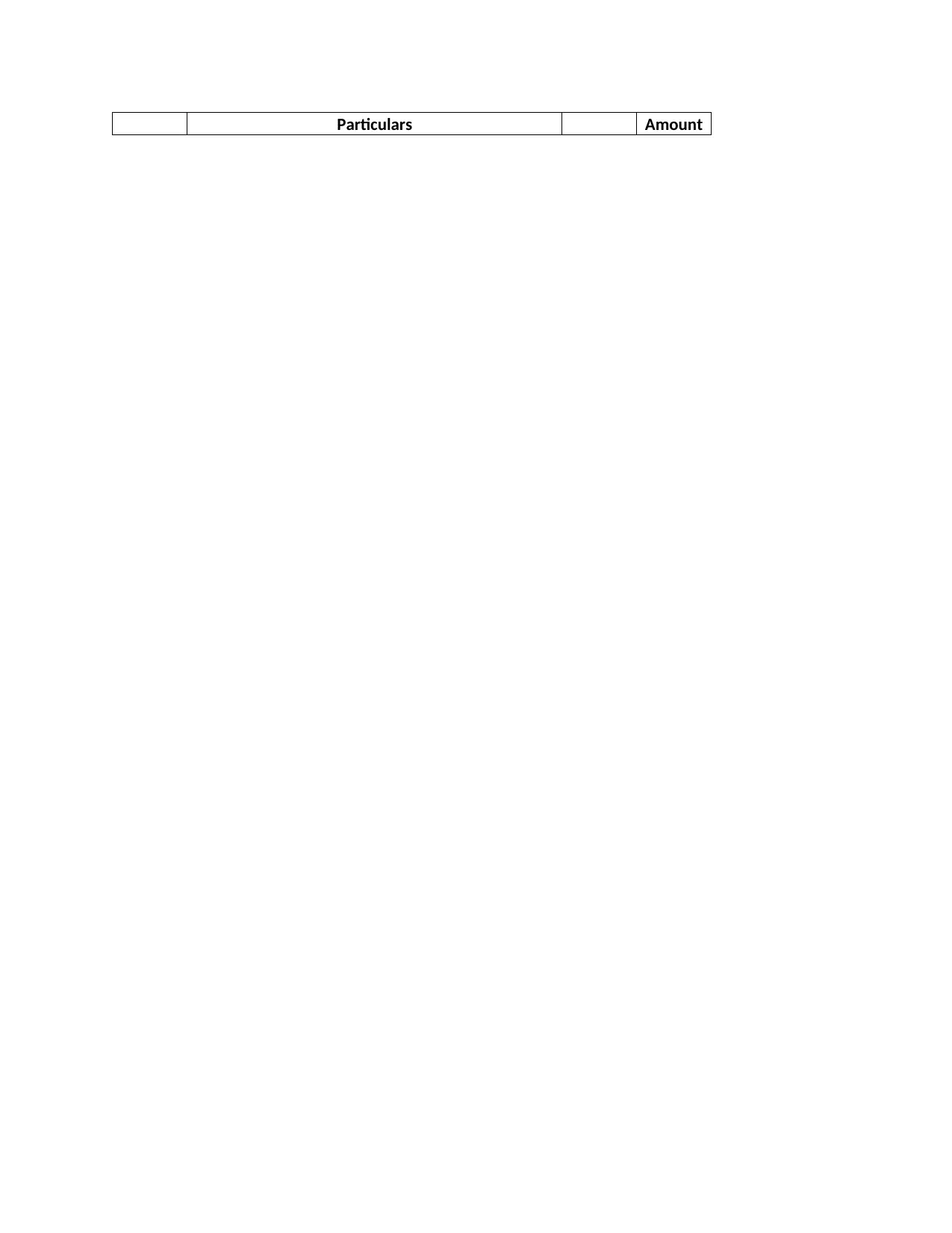
Particulars Amount
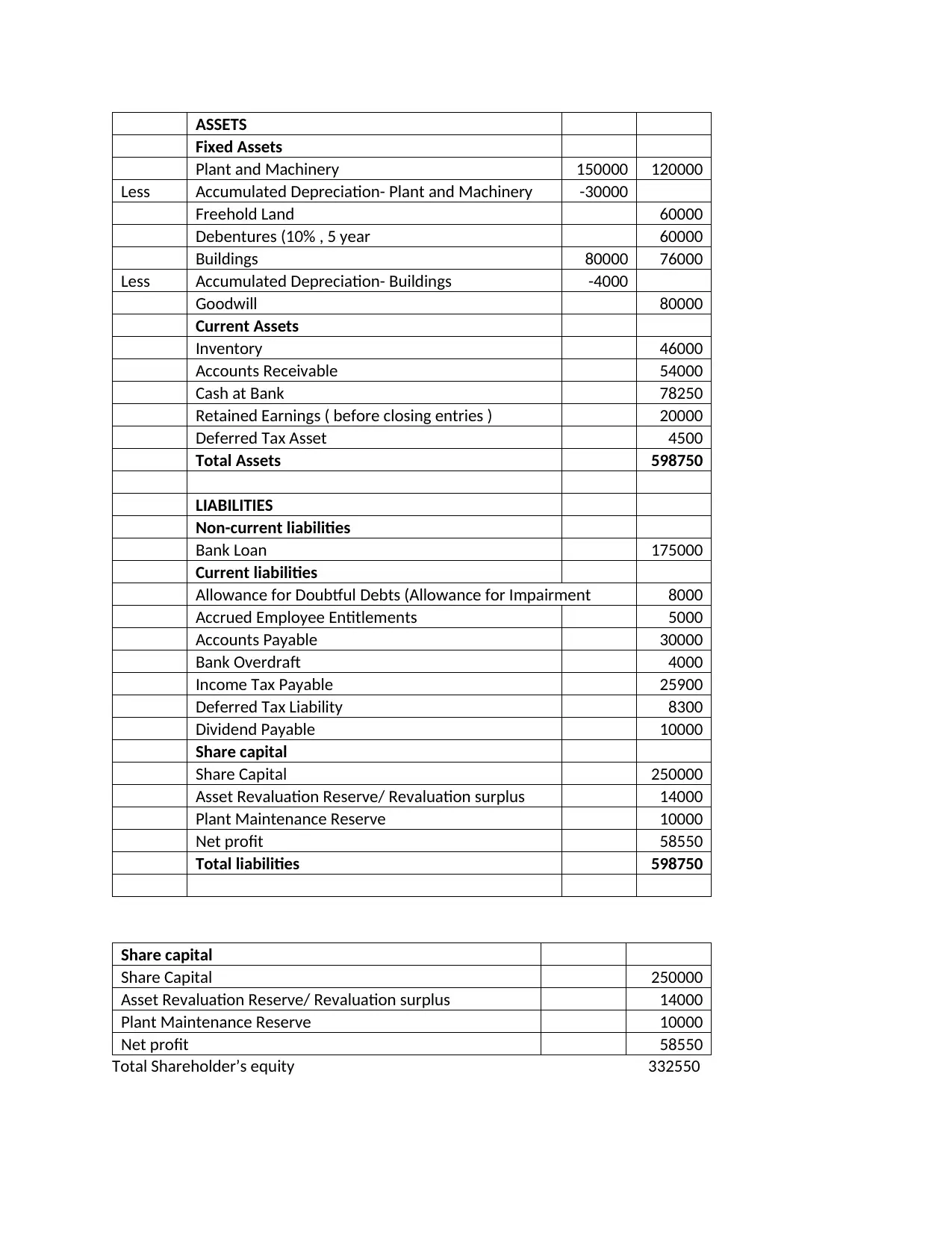
ASSETS
Fixed Assets
Plant and Machinery 150000 120000
Less Accumulated Depreciation- Plant and Machinery -30000
Freehold Land 60000
Debentures (10% , 5 year 60000
Buildings 80000 76000
Less Accumulated Depreciation- Buildings -4000
Goodwill 80000
Current Assets
Inventory 46000
Accounts Receivable 54000
Cash at Bank 78250
Retained Earnings ( before closing entries ) 20000
Deferred Tax Asset 4500
Total Assets 598750
LIABILITIES
Non-current liabilities
Bank Loan 175000
Current liabilities
Allowance for Doubtful Debts (Allowance for Impairment 8000
Accrued Employee Entitlements 5000
Accounts Payable 30000
Bank Overdraft 4000
Income Tax Payable 25900
Deferred Tax Liability 8300
Dividend Payable 10000
Share capital
Share Capital 250000
Asset Revaluation Reserve/ Revaluation surplus 14000
Plant Maintenance Reserve 10000
Net profit 58550
Total liabilities 598750
Share capital
Share Capital 250000
Asset Revaluation Reserve/ Revaluation surplus 14000
Plant Maintenance Reserve 10000
Net profit 58550
Total Shareholder’s equity 332550
Fixed Assets
Plant and Machinery 150000 120000
Less Accumulated Depreciation- Plant and Machinery -30000
Freehold Land 60000
Debentures (10% , 5 year 60000
Buildings 80000 76000
Less Accumulated Depreciation- Buildings -4000
Goodwill 80000
Current Assets
Inventory 46000
Accounts Receivable 54000
Cash at Bank 78250
Retained Earnings ( before closing entries ) 20000
Deferred Tax Asset 4500
Total Assets 598750
LIABILITIES
Non-current liabilities
Bank Loan 175000
Current liabilities
Allowance for Doubtful Debts (Allowance for Impairment 8000
Accrued Employee Entitlements 5000
Accounts Payable 30000
Bank Overdraft 4000
Income Tax Payable 25900
Deferred Tax Liability 8300
Dividend Payable 10000
Share capital
Share Capital 250000
Asset Revaluation Reserve/ Revaluation surplus 14000
Plant Maintenance Reserve 10000
Net profit 58550
Total liabilities 598750
Share capital
Share Capital 250000
Asset Revaluation Reserve/ Revaluation surplus 14000
Plant Maintenance Reserve 10000
Net profit 58550
Total Shareholder’s equity 332550
⊘ This is a preview!⊘
Do you want full access?
Subscribe today to unlock all pages.

Trusted by 1+ million students worldwide

1 out of 10
Related Documents
Your All-in-One AI-Powered Toolkit for Academic Success.
+13062052269
info@desklib.com
Available 24*7 on WhatsApp / Email
![[object Object]](/_next/static/media/star-bottom.7253800d.svg)
Unlock your academic potential
Copyright © 2020–2025 A2Z Services. All Rights Reserved. Developed and managed by ZUCOL.


